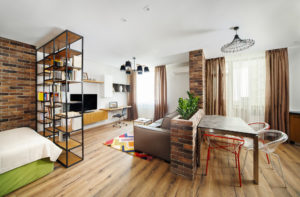If you were considering an architectural landscaping project at your home or office and a landscape designer suggested you put in gabions, what would be your reply? “Great idea?” or “What on earth are gabions?”
If you responded with the latter, you wouldn’t be alone. Convenient, economical, versatile, sustainable, and aesthetically pleasing, these construction elements don’t get nearly the attention they deserve.
What Are Gabions?
The term gabion comes from the Italian gabbione, which literally means “big cage.” Gabions have been in existence for centuries having first been used by the Romans as walls for military defense. And while they are still used for such purposes, today they fill a far greater role in the world of civil engineering and landscape design.
Gabions are cage-like enclosures made of wire mesh and filled with rocks, brick, broken concrete or other hard materials. Supplied in square or cylindrical shape or in curved sections, they are used to form a variety of walls and other structures. Individual gabions are stacked or placed side by side with other gabions each connected to the other by double-twisted wire mesh to form the structures. Typically shipped as flat pack kitsets, they can be easily assembled and filled with local materials on site.
Where Are Gabions Used?
Civil Engineering
Gaetano Maccaferri of Sacerno, Italy is credited for refining and patenting the use of gabions in the late 1800s. They proved to be a strong, durable solution for stabilizing shorelines and steep slopes and for other erosion control problems.
A significant benefit of gabions is that the longer they stay in place, the stronger they become. Because of their open-mesh design, vegetation and silt that grows and accumulates between the cage fill reinforces the wall structure. In addition, because of the permeable construction of gabions, they are less likely to become damaged due to the heavy buildup of water pressure.
Landscaping
From walls to furniture to water features, gabions can be utilized for dozens of different landscaping projects with designers limited only by their own imaginations. Gabions don’t require conventional foundations either, only a compacted layer of crushed rock for individual cages to be seated upon. This coarse rock layer enables the cages to be held firmly in place without a lot of expense. They also do an excellent job of diffusing noise.
One of the most valuable aspects of gabions is that they can be filled with a wide variety of materials to fit individual aesthetic needs or desires. Gabions can be filled with crushed white rock, with smooth gray stones, or with chunks of cement. One can choose to fill their gabions with a more expensive rock for the exterior but with a less expensive choice for the interior portion. And while rock-type materials are the usual choice of fill, so long as it is durable and hard, one can come up with all sorts of creative ideas for their gabions’ contents.
What Are the Best Gabions to Use For My Project?
One of the great features of using gabions is that they don’t require any special engineering skills to assemble or install them.
That being said, one does need to know which gabions to use as not all are created equal. When selecting the right gabions for a project, it is important to know the water and soil conditions the gabions will be used in as they are made with varying cage construction materials. For example, PVC-coated galvanized wire may be fine for a freshwater application with high or low soil acidity, but would not stand the test of time on a shoreline project with exposure to saltwater. In that case, you’ll need gabions made of UV-stabilized polypropylene plastic.
If you’re unsure what types of gabions to purchase for your project, an established supplier can provide the necessary guidance to get you on your way. What you build with them is completely yours to decide.
